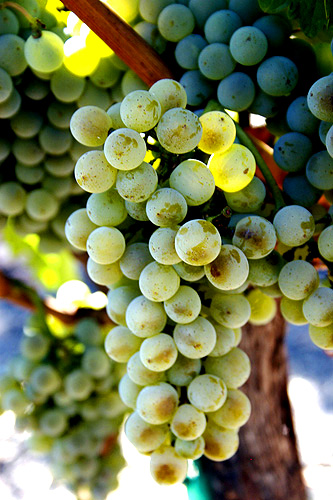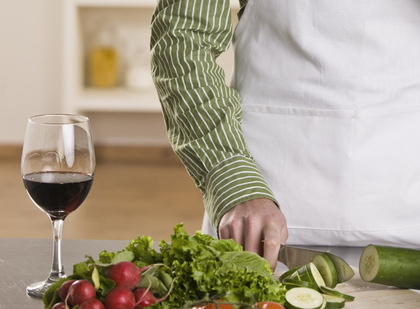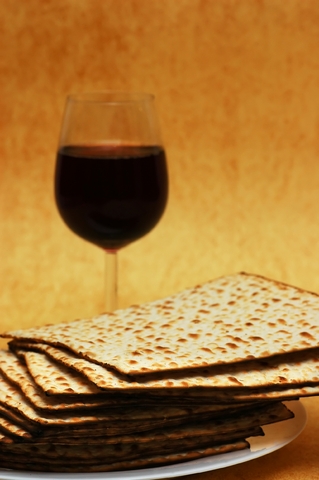by Lorri | Oct 28, 2009 | UnCorked
 Semillon (sem-ee-yon) is a chameleonlike wine. It can be bone dry, rich with ripeness or lusciously sweet. Many consumers are confused by its unusual name and wonder whether semillon is a grape or a French wine region. It is a grape, but much different from others of wider name recognition.
Semillon (sem-ee-yon) is a chameleonlike wine. It can be bone dry, rich with ripeness or lusciously sweet. Many consumers are confused by its unusual name and wonder whether semillon is a grape or a French wine region. It is a grape, but much different from others of wider name recognition.
You may find semillon hidden behind a French Sauternes label or lost within a blended wine. The grape is widely cultivated in Australia and Chile, as wine lovers continue demanding quality wine for less than $10 a bottle.
Few producers let the grape shine on its own, but Hunter Valley has created an exceptional following for those seeking this grape solo. It is dry when young but after about 10 years begins tasting like rich buttery marmalade. Barossa Valley offers a different style with a more steely lime character.
Semillon grapes can produce a great wine, and it is in France’s Sauternes and Barsac regions that this greatness is most often revealed. The grape has a very thin skin, making it perfectly susceptible to noble rot or Botrytis cinerea, a fungus that growers welcome. Well-ripened semillon grapes are blended with sauvignon blanc. Semillon adds weight and the ability to age in oak while sauvignon blanc brings acidity and flavor.
THE VALUES
- 2007 Lindemans Bin 77 Semillon-Chardonnay, Australia (about $10 retail)
- 2008 Jacob’s Creek Winery Semillon-Sauvignon Blanc, Australia (about $11) 2008 Penfold’s Rawson Semillon-Sauvignon Blanc, Australia (about $8)
- 2008 Rosemount Estate Semillon–Chardonnay, Australia (about $9)
THE SPLURGES
- 2007 Cape Mentelle Sauvignon Blanc–Semillon, Australia (about $23)
- 2007 Leewin’s Sibling Semillon-Sauvignon Blanc, Australia (about $22)
- 2005 Chateau Haut-Bergeron Sauternes, France (about $39)
- 2000 Chateau D’Armajan Sauternes, France (about $40)
by Lorri | Oct 21, 2009 | UnCorked
 When it comes to pairing wine and food the most important step is identifying the dominant flavor in the food. However, keep in mind the dominant flavor isn’t necessarily the main ingredient. Sometimes it is a spice or a flavor in the sauce.
When it comes to pairing wine and food the most important step is identifying the dominant flavor in the food. However, keep in mind the dominant flavor isn’t necessarily the main ingredient. Sometimes it is a spice or a flavor in the sauce.
The next step is to focus on the food’s key details — weight, acidity, saltiness, sweetness, texture and flavor intensity.
Weight is the most important component to consider. Instead of thinking white wines with fish and red wines with meat, consider rich foods with rich wines and subtle flavors with light wines.
Examples of rich, robust flavors include beef, lamb, duck, venison, mushrooms, garlic and strong spices such as rosemary or oregano. Also, cooking techniques such as grilling or roasting call for lustier wines.
Light flavors include chicken, veal, fish, pork, and delicate herbs. Cooking methods like steaming, stir-frying or baking call for more nuanced wines.
Wines with high acidity pair best with tart or sour foods. The pairing will complement the food and the wine will taste bright and fresh. Examples of such include dishes with lemon or orange sauces, fresh tomatoes, fresh lemon or lime and feta cheeses.
Saltiness is enhanced by a touch of sweetness or sparkle. Ideal pairings include Roquefort cheese and Sauternes, caviar and Champagne, oysters and sparkling wine, salted mixed nuts and fino sherry or olives and manzanilla sherry.
Tannin is often referred to when describing a wine’s texture. Red wines play the most integral role in food enhancement. If a food is high in fat it will coat the mouth, and tannin’s role is to strip the fat and ready the palate for the next sumptuous bite.
Finally there’s flavor intensity. Intensely flavored wines can be used to contrast rich foods or simply complement the flavor. For example, lightbodied Rieslings or Gewurztraminers are intensely flavored wines and can be used to cut through rich foods such as a curry sauces.
THE VALUES
- Weight: Rich, robust flavors 2007 Root 1 Cabernet Sauvignon Blanc, Chile (about $12 retail)
- Acidity 2008 Casillero Del Diablo Sauvignon Blanc, Chile (about $14 retail)
- Saltiness NV Freixenet Cordon Negro Brut, Spain (about $15 retail)
- Texture 2008 Yali Cabernet Sauvignon, Chile (about $10 retail)
- Flavor intensity 2007 Bloom Riesling, Germany (about $10 retail)
THE SPLURGES
- Weight: Rich, robust flavors 2006 Trapiche Oak Cask Malbec, Argentina (about $16 retail)
- Acidity 2007 Spy Valley Sauvignon Blanc, New Zealand (about $18 retail) Saltiness NV Roederer Estate Brut, California (about $22 retail)
- Texture 2006 Ridge Lytton Springs Zinfandel, California (about $40 retail) Flavor intensity 2005 Hugel Riesling, France (about $26 retail)
by Lorri | Oct 14, 2009 | UnCorked
It’s time to share another page from the memoirs of a tired, teeth-stained wine taster. The recent event, Festival of Wines benefiting the Arkansas Heart Association, offered an exciting tasting experience. Dickey-Stephens Park was filled with an extensive selection of wines ranging from $5 merlots to $200 one-of-a-kind cult wines.

Arriving with my palate fresh and the Uncorked column as my motivation, I fell in line with other guests to explore and enjoy. Following are only some of the wines catching my attention, not only for quality but exceptional value.
THE VALUES
- 2007 Arido Malbec, Argentina (about $10 retail)
- 2007 Andeluna Malbec, Argentina (about $10 retail)
- 2007 337 Cabernet Sauvignon, California (about $10 retail)
- 2008 337 Cabernet Sauvignon, California (about $12 retail)
- 2007 Solena Pinot Gris, Oregon (about $12 retail)
- 2008 Solena Pinot Gris, Oregon (about $12 retail)
- 2008 Santi Pinot Grigio, Italy (about $15 retail)
- 2008 Il Conte Stella Rosa, Italy (about $15 retail)
- 2007 Codice Tempranillo, Spain (about $10 retail)
- 2007 Paso A Paso Verdejo, Spain (about $12 retail)
- 2007 Paso A Paso Tempranillo, Spain (about $12 retail)
- 2008 Yali Sauvignon Blanc, Chile (about $12 retail)
- 2007 La Playa Block Estate Reserve Carmenere, Chile (about $12 retail)
- 2007 Cupcake Sauvignon Blanc, New Zealand (about $12 retail)
- 2008 Oyster Bay Sauvignon Blanc, New Zealand (about $15 retail)
THE SPLURGES
- 2007 Maddalena Cabernet Sauvignon, California (about $16 retail)
- 2007 Botani, Spain (about $19 retail)
- 2006 Volver Tempranillo, Spain (about $18 retail)
- 2006 Solena Grande Cuvee Pinot Noir, Oregon (about $27 retail)
- 2006 Bell Wine Cellars Syrah, California (about $28 retail)
- 2005 Schug Sonoma Merlot, California (about $38 retail)
- 2007 Spann Vineyards Chardonnay/ Viognier, California (about $27 retail)
- 2006 Bell Wine Cellars Chardonnay, California (about $39 retail)
by Lorri | Oct 7, 2009 | UnCorked
 Several readers have inquired about kosher wines recently. And while Rosh Hashana and Yom Kippur have passed, kosher wines aren’t just for holidays.
Several readers have inquired about kosher wines recently. And while Rosh Hashana and Yom Kippur have passed, kosher wines aren’t just for holidays.
Many outside the Jewish community seek kosher wines because of the “bio” friendly production and the strict winemaking practices which include the prohibition of any animal products such as egg whites or gelatin which are sometimes used as fining agents to clarify wine.
The grapes must be from vines that are at least 4 years old and every seventh year the fields must be left uncultivated. There are also strict prohibitions on other crops being grown in the same vineyards.
During the harvest only Sabbath-observing male Jews are allowed to work the vineyards and winery and a rabbi or kashrut-trained supervisor — one versed in the Jewish dietary laws — must observe all steps in the winemaking process.
Following production, 1 percent must be thrown away, a symbolic remnant of the 10 percent tithe, paid to the Temple in Jerusalem.
There are two different types of kosher wines, meshuval and nonmeshuval. Meshuval wine has been heated to near the boiling point, then cooled. This ensures the wine is kosher regardless of how and by whom it is served.
Nonmeshuval wine has not been boiled. If the person who opens or serves the wine is not Jewish, the wine is no longer kosher.
With increased quality and producers including vineyards in France, Spain, California, Italy, New Zealand and Israel, there are many excellent kosher wines to be found. The following are available in Arkansas.
THE VALUES
- 2007 Kesser Concord, New York (about $7 retail)
- 2007 Recanati Cabernet Sauvignon, Israel (about $16 retail)
- 2007 Baron Herzog Chardonnay, California (about $19 retail)
THE SPLURGE
- NV Laurent Perrier Brut, France (about $75 retail)
by Lorri | Sep 30, 2009 | UnCorked
I like to read about wine almost as much as I enjoy drinking it, and a recent trip to the bookstore turned up a provocative wine book on price and its correlation to quality.
The Wine Trials by Robin Goldstein has surprising results from “brown bag” blind tastings. At a brown bag tasting, the wine bottle is literally covered in a brown bag so the taster cannot see any part of the bottle.
The book is the result of 17 blind tastings that were held around the country in 2007 and 2008. They invited more than 500 tasters ranging in age from 21 to 88 and in professions that included wine critics, winemakers, sommeliers, professors, doctors and lawyers. The tasters included everyday wine drinkers and occasional wine drinkers.
The results?
“On the whole, tasters preferred a nine-dollar Beringer Founders’ Estate Cabernet Sauvignon to a $120 wine from the same grape and same producer: Beringer Private Reserve Cabernet Sauvignon. They preferred a six-dollar Vinho Verde from Portugal to a $40 Cakebread Chardonnay … and when we concealed the labels and prices of 27 sparkling wines and asked people to rate them, the Dom Perignon finished 17th — behind 14 sparkling wines that cost less than $15, eight of which cost less than $10.”
The results make sense if you consider the majority of wine drinkers are everyday drinkers and not seasoned collectors or experts. However, the trials did show that experts or those with wine training and experience rated more expensive wines differently and scored them higher than others on the panels.
The following is a selection of some of The Wine Trials’ 100 recommended wines under $15 that beat $50 to $150 wines in the brown bag tastings. Most have appeared as Value recommendations in past Uncorked columns. Taste for yourself — with a brown bag or without.
12 WINES UNDER $15
- 2008 Alice White Chardonnay, Australia
- NV Domaine Ste. Michelle Brut, Washington
- 2007 Mark West Pinot Noir, California
- 2007 Paul Jaboulet Aine Parallele 45 Cotes du Rhone, France
- 2007 Campo Viejo Rioja, Spain
- 2008 Oyster Bay Sauvignon Blanc, New Zealand
- 2008 Crane Lake Sauvignon Blanc, California
- 2007 Fetzer Valley Oaks Merlot, California
- 2007 Concannon Petite Sirah, California
- 2007 Trapiche Malbec, Argentina
- 2007 Rosemount Shiraz, Australia
- NV Freixenet Cordon Negro Extra Dry, Spain
by Lorri | Sep 23, 2009 | UnCorked
Reading what others have written about wine is a wonderful way to discover new wines and keep up with news in the wine world, such as what other oenophiles are up to.
One of the easiest ways to do this is by reading wine blogs. As long as you have access to the Internet, most blogs are free, and there are hundreds, if not thousands out there.
However, keep in mind, not everything you read is accurate, as anyone with access to the Internet can create a blog. Many blogs are filled with thousands of wine-tasting notes and pages of personal opinions and are simply overwhelming.
The following are some of my favorites and are worth the time spent reading.
Vinography.com
- It was a pleasure meeting Alder Yarrow last year at the Wine Writers Symposium. He is one of the pioneers of serious and professional wine blogging. Vinography has a dedicated following because of its comprehensive approach to the discussion of wine and Yarrow’s astounding dedication to his blog. The site addresses many fascinating wine topics and includes reviews, links to newspaper and magazine articles and other bloggers.
Dr. Vino
- It was also a pleasure spending time with Tyler Coleman, aka Dr. Vino, when he spoke to our symposium on wine blogs. As his blog implies, he really is a doctor (the Ph.D. kind) who studied at Northwestern University. The wine connection began when he chose his doctoral dissertation topic about the economics of the wine industry in France and the United States. His site offers a multitude of categories, such as wine regions, quizzes, media updates and reviews. Dr. Vino’s writing skill, range of topics and expertise make his blog a great place to start in the wide world of wine blogs.
WineAnorak.com
- Jamie Goode is a wellknown British wine writer and the architect of Wineanorak. com. The wine anorak is an online magazine, and Jamie’s blog is linked to the site. Both the magazine and blog feature articles on food and wine, book reviews, tasting notes, wine travels and a portfolio of beautiful wine photographs. I enjoy the blog because it has information relevant to novices and professionals.
GoodWineUnder20.blogspot.com
- Good wine under $20 received the title “Best Single Subject Blog” at the 2008 American Wine Blog Awards. Wine blogger Deb Harkness has a special talent for finding good wines from around the world. Her site has expanded into areas other than wine recommendations and explores food and wine pairings, everyday wine culture and interesting wines to enjoy. A nifty tool on her blog is the “topic index,” which allows the reader to find wines by variety, region and price.
 Semillon (sem-ee-yon) is a chameleonlike wine. It can be bone dry, rich with ripeness or lusciously sweet. Many consumers are confused by its unusual name and wonder whether semillon is a grape or a French wine region. It is a grape, but much different from others of wider name recognition.
Semillon (sem-ee-yon) is a chameleonlike wine. It can be bone dry, rich with ripeness or lusciously sweet. Many consumers are confused by its unusual name and wonder whether semillon is a grape or a French wine region. It is a grape, but much different from others of wider name recognition.

